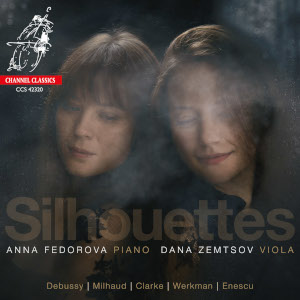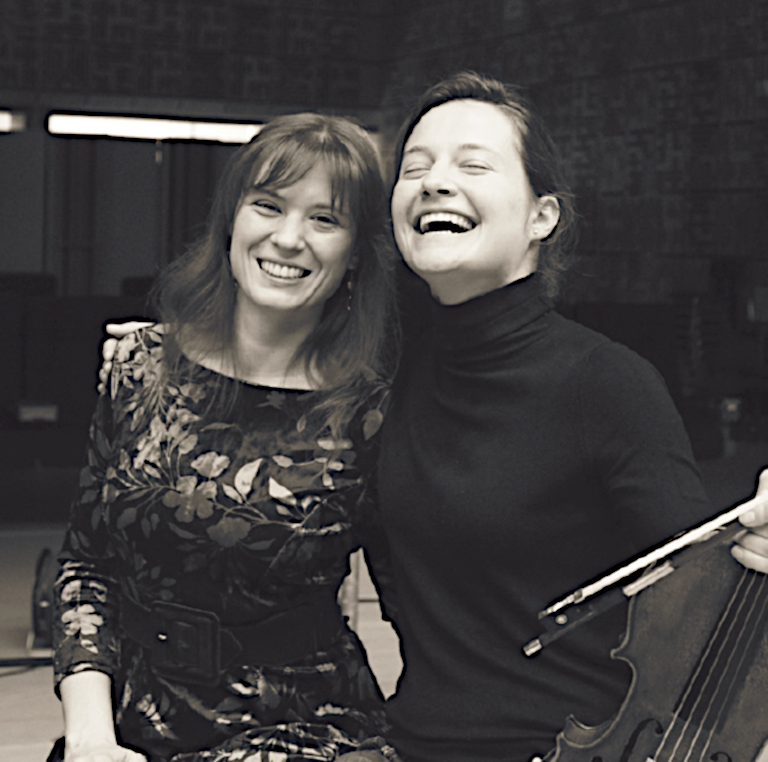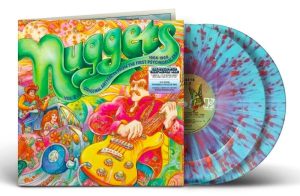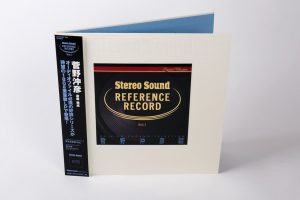Do you recall certain artists whose new releases you eagerly awaited? Anna Fedorova is that artist for us these days. We only recently discovered two of her solo albums on Channel Classics, Storyteller and Four Fantasies. I wrote about these thoroughly engaging releases in a recent article. Now we've found her duo album, Silhouettes, with violist Dana Zemtsov (released 2020). And, oh my, yes. As Ann said to me this morning after listening, the magic just flows!
Silhouettes, Anna Fedorova, piano and Dana Zemtsov, viola, Channel Classics (2020 (DXD, DSD256) HERE
In this new album, Anna Fedorova and Dana Zemtsov partner spectacularly in the works for viola and piano that they have selected to share with us. There is a dance-like magic throughout these performances—delicate precision coupled with airy grace, plus strength and power when called for, Fedorova and Zemstov complement each other perfectly.
The opening work Sonata for viola and piano (1919) by Rebecca Clarke (1886-1979) is a work I'd not known before, by a composer who is new to me. I find it a truly remarkable piece, thoroughly enjoyable after multiple listening's. Clarke grew up in England, studied the violin, and became the first female composition pupil of Sir Charles Stanford (who taught Holst, Vaughan Williams and Bridge) at the Royal College of Music. On Stanford’s advice Clarke switched to the viola and went on to pursue a successful career as a soloist and chamber musician.
In the enclosed booklet, Clemens Romijn writes: "While Clarke described the Viola Sonata as 'that one little whiff of success that I’ve had in my life', the work met with scepticism—'the rumour went around that I hadn’t written the stuff myself', Clarke recalled." Yes, it was simply too good to be the work of a woman in those years. (Not!) In mood, the work has decidedly English roots, but the sounds of Debussy and Ravel infuse it with a forward-looking, distinctly modern, aesthetic.
The next large work on the album is an intriguing new piece by Arne Werkman (b.1960), his Suite for Viola and Piano, op.51 (2007). Here we are firmly grounded in contemporary modern music even as Werkman takes dance motifs of the Baroque in this new direction. From the liner notes: "Through its motoric motion, the pattern of time-honored, contrasting dances such as the Allemande, Branle and Pavane are clearly recognisable, but the harmonies reveal the composer of our time. The Tarantella that brings the suite to a brilliant conclusion is more or less modelled after the tarantellas of the nineteenth-century violin virtuoso Nicolò Paganini." It all works quite delightfully.
The final larger work is by French composer Darius Milhaud (1892-1974), his Sonata No.1 for Viola and Piano, Op. 240, written from 1943-1944. Brought up in a Jewish family in Aix-en-Provence, Milhaud saw no option but to leave France after the Nazi invasion. He found refuge in the U.S. where he was offered a teaching post at Mills College in Oakland, California. Following the end of the war, Milhaud continued to teach alternately at Mills College and the Paris Conservatoire. Milhaud's Sonata No. 1 for Viola and Piano returns us to a theme in this album of music that echoes music of the Baroque, at least in structure, while presenting a thoroughly modern harmonic idiom. This is light-footed music, with significant charm and wit. Fedorova and Zemstov give it distinctive flair.
George Enescu's Concert Piece for Viola and Piano (1906), continues the dance-like musical presentation of this recital. This is a very technically demanding piece for the violist, but beautiful. It was commissioned in 1906 by Gabriel Fauré for student competitions in the Paris Conservatoire and was written accordingly—to challenge one's skills to the utmost. Rhythmic and melodic permutations abound, challenging violists to demonstrate both technical mastery and musical sensibility. "Amongst violists, however, the Concertstück continues to be revered and is a source of great pleasure for those who take on its challenges." (Shiry Rashkovsky 2012)
We close, as we began, with music from Claude Debussy, his delicate and longingly beautiful Beau Soir (1878), transcribed for viola and piano. Throughout this album, our performers intersperse Debussy compositions between the larger works by Clarke, Werkman, Milhaud and Enescu. La Plus que Lente (1910), Clair de Lune (1890/1905) and Beau Soir ground the recital and create a common thread with which to enjoy all of the works presented. You may note that I've used the term recital several times in writing about this album. This is how I experience this album—one deliciously beautiful, fully integrated, recital chosen not simply for several disconnected works of music, but chosen with care to create a musical experience. And an education, which I so greatly appreciate from any album.
Jared Sacks, chief recording engineer, delivers another jewel of a recording. With utter transparency of sound and excellent capture the fine acoustics in MCO studios, Hilversum, Jared continues to impress me with each new recording. Captured with minimal miking to DSD256 tracks, then transferred to DXD for final editing, Jared's recordings continue to reflect an extremely high standard that I highly recommend you experience in the highest resolution playback your audio system can deliver for you. You will be well rewarded.
Highly recommended. Come find a bit of magic for your enjoyment!
Recording session photos by Jonas Sacks, all images courtesy of Channel Classics.












































